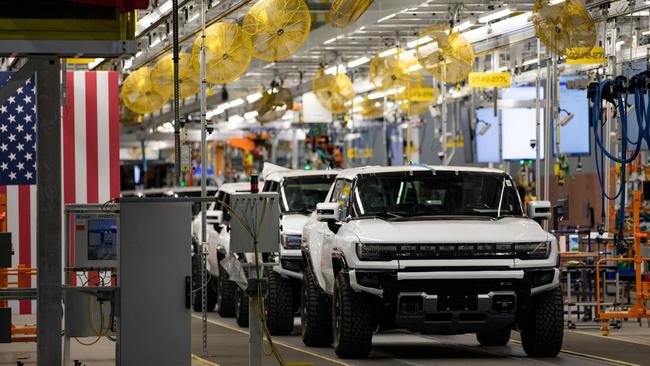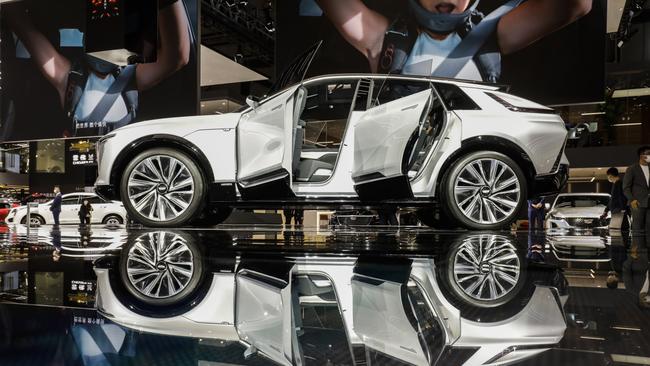Detroit giants charge into EVs: Ford and GM fight back in the switch to electric
Ford and General Motors, the two largest US carmakers, are bringing electric vehicles to the American masses as they challenge Tesla’s dominance with cheaper products.

At Ford’s new electric vehicle plant outside Detroit, the electric version of the biggest-selling car in the US for 45 years, the F-150 truck, is being made the same way as it drives: quietly, and quickly.
No earmuffs required to tour the new $US700m ($932m) facility to build the F-150 Lightning, nestled amid Ford’s gigantic River Rouge Complex, the biggest car plant in the world when it opened in 1928.
Giant robotic claws insert 800kg batteries, around the size of two mattresses, into the chassis as part of a process that dispenses with the noisy conveyor belts required to build traditional combustion engine vehicles.
Ford and General Motors, the two largest US carmakers, are bringing EVs to the American masses as they challenge Tesla’s dominance of the electric-vehicle market with new, cheaper products they believe people will buy whatever they think about climate change.
“They are just better cars,” Travis Hester, GM’s chief EV officer, tells The Weekend Australian.
The two Detroit-headquartered auto giants, written off after near-death experiences in the late 2000s following decades of shrinking market shares and humiliation by nimbler European and Asian competitors, are fighting back.
Still fiercely competitive, both have spent billions of dollars in the past few years on new electric-vehicle models and production capacity, and both will start taking orders for new mass market models within the next two months. The models’ success or failure will weigh heavily on the Biden administration’s target for half of new car sales to be EVs by 2030.

Production has already started for the Ford F-150 Lightning, an electric version of the most popular vehicle (and truck) in the US for 45 years in a row. It will retail for under $US40,000 ($53,200), about 20 per cent cheaper than the lowest-cost Tesla.
“It’s signalling to customers we’re serious about electrification,” Linda Zhang, Ford’s chief designer for the F-150, tells The Weekend Australian. “We’re not looking at niche, uber expensive, we’re looking at mainstream products that are super affordable and fun to drive.
“Initially there was a lot of scepticism. When you think truck you think durability, capability, and EVs prior to now haven’t been known for that,” she adds, reminding me the prototype F-150 had pulled a 450,000kg train to convince sceptics.
Ford, which earlier this month said it would split its company into separate electric and petrol divisions, expects EVs to account for one-third of its global sales by 2026 and half by 2030, up from a previous target of 40 per cent.
The Cadillac Lyriq, meanwhile, GM’s third fully electric car after the niche top-range Hummer and a humiliating recall of the Chevrolet Bolt, began rolling off the production line in Tennessee earlier this week, with a price tag of just under $US60,000.
“Our approach is very much EVs for everyone,” says Hester, one of a handful of senior Australians who help run GM in Detroit, including design chief Michael Simcoe. GM has already announced eight of the 30 new models promised by 2025, putting GM on the path to sell only EVs by 2035.
Simcoe says: “I was chief engineer (at GM) for a long time. For my entire career I was trying to eliminate turbo lag, have instant acceleration, make the car quieter, more interior space, and electric vehicles have all that instantly.”
Investors appear to have welcomed their investments so far.
Since March 2020, Ford’s share price has tripled and GM’s has doubled – nothing like the 10-fold gains Tesla shareholders have enjoyed over the same period, but a lot better than the pair had been used to after years of trying to convince investors they could survive their crushing, multibillion-dollar legacy pension obligations.

Electric-vehicles still only made up about 3 per cent of the 15 million light vehicles sold in the US last year, far below their 15 per cent share in China, the biggest global market where about 3.3 million EVs were sold last year, up from 1.3 million a year earlier.
“The adoption we’ve seen over last three, four years has exceeded most of the prediction models; we’re on track to be well above 30 per cent of new sales by 2030,” Hester says.
Ford and GM, which combined sold about 4 million light vehicles in the US last year, are on track to dominate the EV market by the end of the decade, if Tesla’s high-end products stabilise at about 500,000 sales a year in the US.
The two carmakers are convinced drivers will come to appreciate that the latest generation of electric-vehicles are superior to internal combustion engine products, which benefit from nostalgia, familiarity and the perception that EVs are elitist.
“You can say the numbers on paper but until you get in the vehicle you don’t realise the remarkable feeling,” Zhang says as she accelerates onto the highway near Ford’s HQ outside Detroit, pinning my body into the chair.
“This sucker’s quick”, Joe Biden said in May when the US President test drove the F-150, demonstrating its ability to accelerate from 0 to 100km/h an hour in about four seconds.
Range anxiety – the fear of running out of power on long trips – remains the biggest obstacle to electric-vehicle purchase.
“Normally you could get to Washington DC in two charges no problem, but right now with winter the temperature’s low and the battery doesn’t go as far, it says three,” says Zhang, punching in a DC address so the F-150’s on-board system can calculate the optimal path for the 844km drive.
Even now, 90 per cent of the US population lives within 16km of an EV charging station. And that’s before General Motors announced it would spend $US750m building as many as 40,000 across the US and Canada.
“Our vision is to have at least a bank of these every 50 miles [80km] across the 47,000 miles of highways in the US and Canada,” Hester says. The Biden administration allocated $US7.5bn last year to build 500,000 charging stations by 2030.
The electricity sector hogs the limelight in debates about policies to reduce carbon dioxide emissions, but transport generates about 30 per cent of US carbon dioxide emissions, more than any other sector.
EVs are cheaper to run, too. Zhang says her household electricity bill increased by about $US30 a month after she bought a Mustang Mach-E, another of Ford’s fully electric offerings, saving $US400 a month on petrol.

Then there’s the “frunk”: without an engine, the area under the bonnet becomes a second boot, not a minor consideration for those who need to carry large items around. And if your suburb is prone to blackouts, the F-150, at least, can power a house for at least three days.
While they wouldn’t say it, soaring oil prices following the outbreak of war in Ukraine provide a perfect backdrop for the launch of new EVs, when bowser prices in the US have broken records. Indeed, a study by three University of California economists, published last week, found potential California EV customers were far more likely to buy one when petrol prices were higher.
“The influence of gasoline prices is roughly four to six times stronger … than is the influence of electricity prices,” they concluded, arguing that consumers’ inferior understanding of prevailing electricity prices and how they related to the cost of running their EV would improve over time.
Even without the Biden administration’s $US12,500 Build Back Better subsidy to buy new cars made with union labour, which failed to pass the US congress last year, demand for Ford and GM electric-vehicles has been strong, belying the perception EVs were a relatively niche product.
Ford had to cap pre-launch sales at 200,000 and has doubled its annual production capacity for the Lightning to 150,000 a year.
“We’ve had a lot of requests from Australia actually,” Zhang says, but adding the truck would not be headed to Australia initially. Australian EV sales were about 2 per cent of new cars last year, made up mainly of Teslas.
Without thousands more charging stations, Australia could see less interest from the big global manufacturers that are switching to EV technology.
“The countries with deepest adoption like China, Europe and the US correlate very strongly with two policies: charging infrastructure, led by government or private, and the other is incentives for a vehicle, like tax,” Hester says.
The petrol-powered F-150 has been serious business for Ford, generating about $40bn in revenue in 2019. For the electric version to come anywhere near its success, Ford and GM, for its part, will have to ensure ready supplies of semiconductors, particularly critical in EVs, and batteries, which require minerals such as lithium and nickel. “A lot of raw materials comes out of the Russia, nickel the big one,” Hester says, noting the problems the war in Ukraine would cause the industry.
“We’re continually working on chemistries in batteries with more or less nickel.”



To join the conversation, please log in. Don't have an account? Register
Join the conversation, you are commenting as Logout